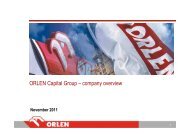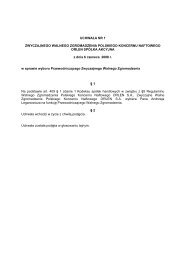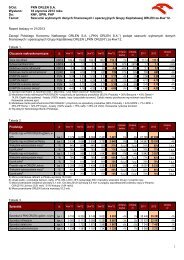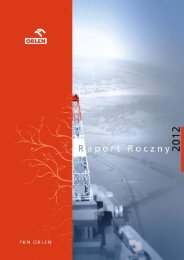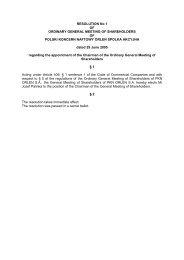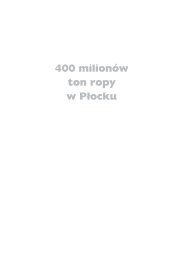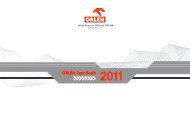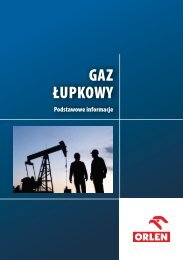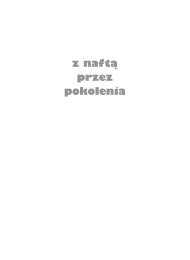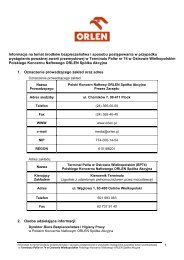Corporate responsibility report / Responsible brand - PKN Orlen
Corporate responsibility report / Responsible brand - PKN Orlen
Corporate responsibility report / Responsible brand - PKN Orlen
Create successful ePaper yourself
Turn your PDF publications into a flip-book with our unique Google optimized e-Paper software.
Environmental and social <strong>responsibility</strong><br />
Two accelerators (A-4 and A-5) from water decarbonisation<br />
process were used in the 3rd stage of wastewater<br />
treatment. Here it was possible to repeatedly use sediment<br />
from raw water decarbonisation process in wastewater<br />
coagulation process.<br />
Wastewater is used as industrial water for cleaning,<br />
washing and fire fighting purposes.<br />
The new technologies yielded environmental and economic<br />
benefits. The volume of water uptaken from and wastewater<br />
discharged to the Vistula has significantly dropped.<br />
However, the closed water circuit, apart from advantages,<br />
caused certain problems and restrictions. In 2000,<br />
we resigned from directing reversed wastewater to cooling<br />
systems, as it resulted in excessive salinity of water at water<br />
blocks. High salinity of circulating water made it necessary<br />
to desalt cooling systems and as a consequence caused<br />
increased ballast water discharge to the wastewater<br />
treatment plant. Thus, in order to be able to still use<br />
recycled water, we will have to reduce salt consumption<br />
in the water and wastewater system. Proposal to be applied<br />
Amount of waste generated in 2008–2009*<br />
Volume [‘000 Mg]<br />
2008 2009<br />
Total generated waste: 11.9 7.8<br />
including: – hazardous waste 4.3 4.7<br />
– other waste (excl. municipal waste) 7.6 3.1<br />
* according to data for the Polish Central Statistical Office.<br />
Waste utilisation methods in 2008–2009<br />
Volume [‘000 Mg]<br />
2008 2009<br />
Recovered 10.7 10.7<br />
Total neutralised waste 0.5 0.8<br />
including: – thermal 0.3 0.5<br />
– stored 0.2 0.1<br />
– other 0.0 0.2<br />
Stored waste 0.7 0.8<br />
in this scope may be the use of membrane processes,<br />
e.g. reverse osmosis process (in place of ion exchangers)<br />
which is carried out without the use of chemicals.<br />
In 2008, we <strong>report</strong>ed a significant drop in the amount<br />
of gene rated waste in the group of waste other than<br />
hazardous. This was the effect of completion in 2008<br />
of preparatory works for investments projects. Works carried<br />
out in 2009 were not associated with generation of increased<br />
amount of waste. The amount of recovered waste<br />
remains stable at approx. 90% ratio to generated waste.<br />
In 2009 we generated 4.7 thousand Mg of hazardous<br />
waste, of which 3.5 thousand Mg were directed to recovery<br />
processes outside the territory of Poland, whereas<br />
the remaining 1.2 thousand Mg of hazardous waste were<br />
supplied to Polish recipients.<br />
In 2009, no accidental release of hazardous substances<br />
happened at the Production Plant in Płock which could<br />
affect human life, soil, vegetation, water reservoirs or underground<br />
water.<br />
Transfer of hazardous waste in 2009 was carried out<br />
in the following way:<br />
• within the territory of Poland<br />
– for the purpose of recovery – 265.0 Mg,<br />
– for the purpose of neutralising – 502.4 Mg;<br />
• to other countries for the purpose of recovery –<br />
4,372.4 Mg.<br />
This applied both to waste generated in 2009 and stored<br />
from the previous years.<br />
The proper operation of the Production Plant in Płock<br />
was checked by the Masovian Regional Environmental<br />
Protection Inspectorate, which performed 3 checks<br />
in 2009, of which one was a comprehensive check, one<br />
was investment project check and one was a check with<br />
respect to major failures. The results of the checks did not<br />
reveal any parameters in excess of the limits determined<br />
in relevant permits and decisions, and no penalties were<br />
imposed. A post-check disposition was issued stipulating<br />
recommendations concerning the requirement to notify<br />
the Regional fire Service Chief and the Regional Environmental<br />
Protection Inspector about the date of termination<br />
of the use of Olefin I unit.<br />
/ 64



